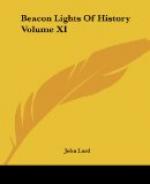BY JOHN BASSETT MOORE, LL.D
While the Revolution had severed the tie which bound the colonies to the mother country and had established the independence of the United States, the task of organizing and consolidating the new nation yet remained to be performed. The Articles of Confederation, though designed to form a “perpetual union between the States,” constituted in reality but a loose association under which the various commonwealths retained for the most part the powers of independent governments. In the treaty of peace with Great Britain of 1782-83, strong national ground was taken; but the general government was unable to secure the execution of its stipulations. The public debts remained unpaid, for want of power to levy taxes. Commerce between the States as well as with foreign nations was discouraged and rendered precarious by variant and obstructive local regulations. Nor did there exist any judicial authority to which an appeal could be taken for the enforcement of national rights and obligations as against inconsistent State laws and adjudications. These defects were sought to be remedied by the Constitution of the United States. But, as in the case of all other written instruments, the provisions of this document were open to construction. Statesmen and lawyers divided in their interpretation of it, according to their prepossessions for or against the creation and exercise of a strong central authority.
Among the organs of government created by the Constitution was “one Supreme Court,” in which, together with such inferior courts as Congress might from time to time establish, was vested “the judicial power of the United States.” This power was declared to extend to all cases, in law and equity, arising under the Constitution itself, the laws of the United States, and treaties made under their authority; to all cases affecting ambassadors, other public ministers and consuls; to all cases of admiralty and maritime jurisdiction; to controversies to which the United States should be a party; to controversies between two or more States, between a State and citizens of another State, and between citizens of different States, as well as between citizens of the same State claiming lands under grants of different States, and between a State, or the citizens thereof, and foreign States, citizens, or subjects. In all cases affecting ambassadors, other public ministers and consuls, and those in which a State should be a party, the Supreme Court was vested with original jurisdiction, while in all the other enumerated cases its jurisdiction was to be appellate. With the exceptions of suits against a State by individuals, which were excluded by the Eleventh Amendment, the judicial power of the United States remains to-day as it was originally created.




